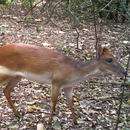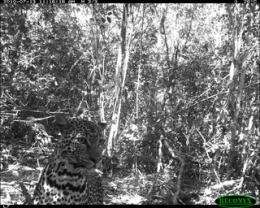Rare antelope reveals secrets of threatened African forest

A new population of Africa’s most critically endangered forest antelope is living in a highly threatened forest in Northern Kenya, scientists can reveal.
Conservationists are calling for the immediate preservation of the Boni-Dodori forest after camera traps set up by the Zoological Society of London (ZSL), the Kenyan Wildlife Service (KWS), Whitley Wildlife Conservation Trust (WWCT), National Museums of Kenya and the WWF discovered a new population of Aders’ duiker (Cephalophus adersi), a very rare small forest antelope.
Camera trap images from the Boni-Dodori forests in north coastal Kenya have found the world’s largest known population of Aders’ duiker, which until these surveys, was only known to exist in diminishing forest patches on Unguja Island, Zanzibar and the Arabuko-Sokoke forest in coastal Kenya.
Over 3,300 images of the antelope were recently captured on 52 camera traps set up by researchers who recognised the distinctive animal by the white ‘wrap-around’ band on its lower thigh and rich mahogany chestnut tone on its upper back.

The camera trap pictures also revealed important populations of a number of species such as African wild-dogs (Lycaon pictus), elephants (Loxodonta africana) and lions (Panthera leo), living in and around the biodiverse forest, which is currently under threat from rapid coastal and agricultural development.
The scientifically significant snapshots come only months after the discovery of a potentially new species of giant sengi, otherwise known as an elephant-shrew (Macroscelidea), in the same area.
The biodiversity of the forest is poorly understood due to security problems and poor infrastructure limiting access for scientists.
ZSL senior conservation biologist, Dr. Rajan Amin said: “The significant Aders’ duiker population in the Boni-Dodori is yet another important discovery, after that of a potentially new species of elephant shrew last year.
“This population is a lifeline for the critically endangered antelope, which until now was thought to exist only in tiny populations in coastal Kenya and Zanzibar. Given time and conservation action we could unearth even more new species in this isolated forest, but we are running out of time to stop the forest and its hidden secrets from being destroyed by rapid coastal development.”
Andrew Bowkett of WWCT added: “This forest is extremely biodiverse and is a very important area to conserve. We have also found other important populations of forest antelopes in the area including the Harvey’s duiker (Cephalophus harveyi), Suni (Nesotragus moschatus) and the Blue duiker (Philantomba monticola) which was also not previously known to occur in the Kenyan northern coastal forests”.
Dr Sam Andanje, Head of Ecosystem and Landscape Conservation at KWS, who is leading the national effort to conserve the forests, said “We will use the new information on Aders’ duiker and other important findings from this research to work closely with key stakeholders to develop effective strategies to conserve and protect these areas.”
Provided by Zoological Society of London





















